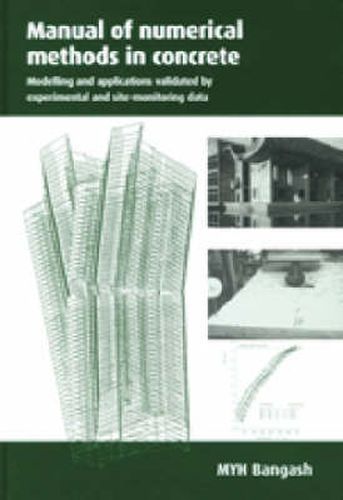Readings Newsletter
Become a Readings Member to make your shopping experience even easier.
Sign in or sign up for free!
You’re not far away from qualifying for FREE standard shipping within Australia
You’ve qualified for FREE standard shipping within Australia
The cart is loading…






The modelling of constitutive equations to represent the isotropic and anisotropic behaviour of concrete in structures remains one of the most difficult tasks in structural engineering. At present, analyses on concrete structures are carried out for elastic, plastic and cracking conditions under static and dynamic and blast loads. The behaviour of concrete under complex loads cannot easily be assessed by codes of practice or by simplified empirical formulae. Manual of numerical methods in concrete aims to present a unified approach for the available mathematical models of concrete, linking them to finite element analysis and to computer programs in which special provisions are made for concrete plasticity, cracking and crushing with and without concrete aggregate interlocking. Creep, temperature, and shrinkage formulations are included and geared to various concrete constitutive models. Their influence is taken into consideration in the operational and overloading behaviour of concrete structures, using linear and non-linear methods of analysis. Static and dynamic impactive and blast loadings are simulated in the interactive formulation. The book is divided into three sections: Part One begins with a literature review of the basic properties of concrete, including the effects of temperature, creep and fatigue. It goes on to look at various analytical and mathematical models for concrete and several constitutive models and then considers the important bond and bond-slip phenomenon, concluding with a comparative study of results from the empirical formulae for the fatigue of concrete with these obtained using finite element and other numerical techniques. Part Two focuses on finite element analysis and the simulation techniques of various concrete numerical models. It includes a step-by-step formulation of the finite element analysis of concrete structures as well as material modelling of major constitutive equations given in earlier chapters. It goes on to consider seismic criteria and numerical modelling of soil-concrete structure interaction with and without isolators, discussing structural design requirements for concrete structures. Part Three applies the theory discussed in the first two parts. Case studies have been selected from various areas of civil/structural, earthquake, offshore, nuclear, demolition and retrofit engineering, taking care to include structures which are supported by experimental test results and/or site monitoring. The book also contains extensive appendices with supporting data and computer subroutines. Manual of numerical methods in concrete is an essential reference work for engineers, technologists, designers and research students - all those involved with concrete structures.
$9.00 standard shipping within Australia
FREE standard shipping within Australia for orders over $100.00
Express & International shipping calculated at checkout
The modelling of constitutive equations to represent the isotropic and anisotropic behaviour of concrete in structures remains one of the most difficult tasks in structural engineering. At present, analyses on concrete structures are carried out for elastic, plastic and cracking conditions under static and dynamic and blast loads. The behaviour of concrete under complex loads cannot easily be assessed by codes of practice or by simplified empirical formulae. Manual of numerical methods in concrete aims to present a unified approach for the available mathematical models of concrete, linking them to finite element analysis and to computer programs in which special provisions are made for concrete plasticity, cracking and crushing with and without concrete aggregate interlocking. Creep, temperature, and shrinkage formulations are included and geared to various concrete constitutive models. Their influence is taken into consideration in the operational and overloading behaviour of concrete structures, using linear and non-linear methods of analysis. Static and dynamic impactive and blast loadings are simulated in the interactive formulation. The book is divided into three sections: Part One begins with a literature review of the basic properties of concrete, including the effects of temperature, creep and fatigue. It goes on to look at various analytical and mathematical models for concrete and several constitutive models and then considers the important bond and bond-slip phenomenon, concluding with a comparative study of results from the empirical formulae for the fatigue of concrete with these obtained using finite element and other numerical techniques. Part Two focuses on finite element analysis and the simulation techniques of various concrete numerical models. It includes a step-by-step formulation of the finite element analysis of concrete structures as well as material modelling of major constitutive equations given in earlier chapters. It goes on to consider seismic criteria and numerical modelling of soil-concrete structure interaction with and without isolators, discussing structural design requirements for concrete structures. Part Three applies the theory discussed in the first two parts. Case studies have been selected from various areas of civil/structural, earthquake, offshore, nuclear, demolition and retrofit engineering, taking care to include structures which are supported by experimental test results and/or site monitoring. The book also contains extensive appendices with supporting data and computer subroutines. Manual of numerical methods in concrete is an essential reference work for engineers, technologists, designers and research students - all those involved with concrete structures.